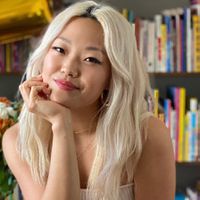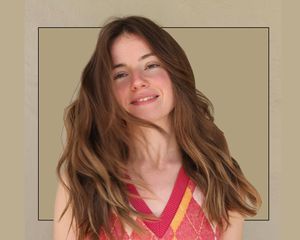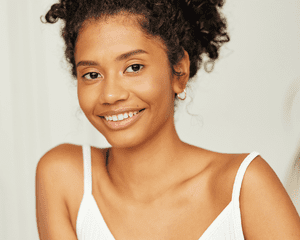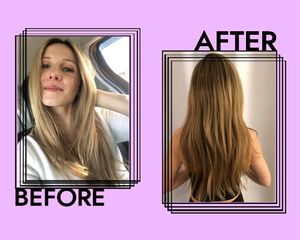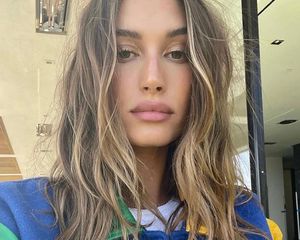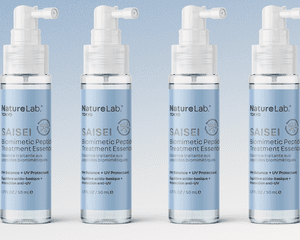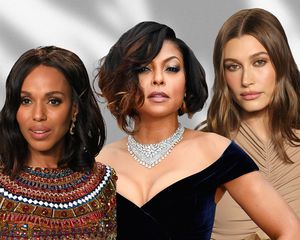:max_bytes(150000):strip_icc()/blonde-hair-f472abacde9a456481fac44c9336a264.png)
@matildadjerf / Instagram
Ever found yourself scrolling through post after post of honeyed tresses and wondering, "Should I dye my hair blonde?" Same. We've experienced similar sun-kissed thoughts and golden reveries come warmer months, but to actually take the plunge? That takes guts, commitment, and a whole lot of research. While we can't help but cheer you on through those first two barriers, we can definitely supply the goods when it comes to research—and even do you one better: a first-hand account of what the process of going blonde (sans damage, we might add) is really like.
Read on for one editor's personal experience transitioning to blonde along with product recommendations and expert insight from professional colorists.
Meet the Expert
- Tiffanie Richards is Master Colorist at Louise O’Conner Salon in New York City.
- Rex Jimieson is a colorist at Maxine Salon in Chicago.
Before Taking the Blonde Plunge
Last summer, I spent a solid six months talking about dying my hair blonde. For the past six years, I'd been embracing my natural (what some may call "mousy") brown color in an effort to give my stressed-out tresss a break from being colored every color but blonde. (Don't get me wrong; I've dabbled in subtle highlights, but I never fully committed—I was afraid I'd ruin my now-virgin strands.) Now I wanted to be blonde blonde but still look natural (read: not peroxide blonde). And, of course, I wanted my hair to be healthy. In short: I wanted a lot.
If you're unsure of whether take the plunge, Jimieson suggests trying on wigs. "The exact color of the wig is likely achieved with textile dye so be flexible on the results," he explains. "This is just a first step if you need the visual before going further."
I was already convinced so I decided to head to my new favorite salon, Buller and Rice (which is conveniently 15 minutes from my flat). Buller and Rice's focus on sustainable haircare and eco-friendly practices are what really sets them apart from other salons. For me, going blonde as ethically as possible was an important factor, as was maintaining healthy hair with eco-friendly products, so I knew I'd be in good hands there.
How to Prep Hair for Processing
Before your first appointment, make sure hair is ready to be processed. "Thoroughly wash and condition your hair the day before," instructs Jimieson. "Washing the same day can sensitize the scalp, but oils and build up can hinder the ability of the lightener, bleach, or dyes."
"Be honest with your colorist as to what is already on your hair. If your hair is long, chances are color from a year ago is still on the ends of your strands," says Richards. "A good clarifying shampoo can help remove any build up that has been sitting on the strands to help create a blank slate for lightening."
The Process of Going Blonde
We started off the entire process having a big chat about the type of blonde I wanted to be. This is exactly why it's crucial to consult with your hairdresser first. Blonde hair falls into multiple categories, including icy-white blonde and balayage, so it's important you and your stylist are on the same page. "A colorist can guide you to what looks best on you, however, it's a 50/50 split. The client has to like the statement and vibe of the color, but every colorist also has their own personal taste," says Jimieson. "Collect images of blond hair you like and dislike. If a colorist says it's not right for you, try another colorist. If you get the same answer more than once, listen to what the experts are telling you. Don't rush in! While three levels of lift is a classic safe amount to lighten and not damage or conflict with your skin/base color, some will love pale ash shades."
Byrdie Tip
According to Jimieson, ashy blondes will require more makeup, more conditioning, and more mindfulness when picking out clothing.
Rice and I both agreed I needed to stay away from brassy tones, but because my hair has a slight golden tone to it, I'd need regular toning treatments to whiten it up a little. "Everyone has underlying warmth in their hair and you can enhance or counter that pigment with toner," explains Jimieson. "Wherever you start you have those tones and all the others going up the chart that will be revealed during the lifting process. Everyone lifts warm."
We also agreed we wouldn't take the color right up to the root. Instead, we'd smudge it in to make it look more natural. "Your colorist will guide you in what is achievable and what is not. This all depends on your natural color, hair texture, previous hair color you’ve had and health of your hair," adds Richards. "Your colorist will guide you in the right direction. This includes what shades and tones of blonde will work for your skin tone and level of maintenance you’d like. Keep in mind, the darker your hair naturally is, the more difficult it is going to be to battle warm tones."
The thing with going blonde is that it's a process. You have to really want to commit, but trust me—it's worth it. "Depending on what we’re starting with and what you’re looking to achieve, blonde can be achieved in 1-3 appointments," says Richards. "Of course those needing a more gentle approach will be the latter. The #1 rule for going blonde is go in with realistic expectations. The more honest you are with your colorist about what you have previously done with your color will allow you to get to your goal blonde on the fastest and healthiest route."
"While some blonding services can get you there in a day (single and double process), other techniques for more custom colors like foils and balayage accumulate over time," explains Jimieson. "More isn't always more. When more is more, adding more pieces of blond should be the goal, re-bleaching hair that has already been bleached is a risky business I do not recommend. Quantity takes time, levels of lift are determined by your natural pigment combined with any artificial dye pigments you already have in your hair. Be realistic and trust your professional."
How to Care for Hair During the Process
Going blonde puts so much stress on your hair, so it's important to invest in the products you put on your hair both during the bleaching process and after. "Lightening your hair can be gentle, subtle and low maintenance but it can also be an aggressive ambitious move," says Jimieson. "The amount of damage will depend on the goal and the proper use of the product by the colorist and the aftercare the client chooses for home."
Rice added a new treatment by Davines to the bleach before we applied it to my hair. This helped to repair the bonds from bleaching but was also meant to restructure any that were already broken. "Olaplex is a colorists best friend while blonding," notes Richards. "This will be mixed directly into the lightener and will help prevent any possible damage. It will then be followed by a post color treatment."
"Follow the product regimen recommended by your colorist religiously, if the product isn't working out, ask your colorist for an alternative," adds Jimieson.
Results


And after two swift visits to see Buller and Rice's salon co-owner Anita Rice, I'm now blonde (and loving it). So it's safe to say I'm going to have to go back to the hairdresser's every six to eight weeks for top-ups, trims, and toning treatments.
Cost
According to Richards, blonde highlights begin at $400 and range up from there depending on what you're looking to achieve.
"Costs will vary greatly depending on your area's cost of living, level of salon chosen, level of colorist experience/knowledge, and choice of technique(s)," says Jimieson. "It's always wise to get a consultation that includes a price range and ask what is the most it could cost."
Potential Side Effects
"Breakage can be a potential side effect and is quite normal when diving into a new color involving lightener," explains Richards. "A little bit of breakage is not desired but is okay and can be fixed/maintained. If this happens, don’t be turned off and hop to another colorist as this will continue to happen and most likely get worse. Instead, let your colorist know for your next appointment and they can adjust as needed."
"Aggressive blonding can result in breakage but it can be from many things. It's rarely the lightener or dye, but the misuse of them," adds Jimieson. "Too much heat styling, or previous damage can be a huge component in a breakage scenario. Dryness or loss of shine can occur but this is easily fixed with proper home care."
Aftercare
One thing I've learned about being a blonde is that aftercare is essential. I'll admit that before I dyed my hair, I didn't use any products. In fact, I washed it with any shampoo and never ever used a conditioning treatment. That changed the evening I left the salon with nurturing drops in my hand, but more on that later. Aftercare is fundamentally vital, as when you dye your hair, the bleach damages hair and can leave it feeling brittle.
Rice told me the most important thing you can do post–salon visit is get a great shampoo and conditioner like the O Way Hydrating Hair Bath and Smoothing Conditioner. All O Way products are bio-dynamically farmed, which means they use the highest quality natural oils for the best results, and I can confirm they leave your hair super soft and super shiny (even two days post-wash can leave treated blonde hair looking a little dull). "Professional shampoo, conditioner, and a heat protectant are a must," adds Jimieson. "You will most likely need a deep conditioner if you went more than three shades lighter than you came in with."
But aftercare doesn't stop with shampoo and conditioner. I've been using the O Way Nurturing Drops since I dyed my hair, and they've now become my most-used product. After showering, I run a small amount of the drops through my ends to ensure they don't look brittle or dry. I even use it when my hair is feeling dry, and I can honestly say they leave it looking as shiny and feeling as soft as it did when my hair was in its natural state.
"Hydration is key. If you don’t do your homework with your hair chances are breakage will most certainly happen at some point," says Richards. "I recommend HASK BLONDE CARE Deep Conditioner Treatments for keeping blond hair strong and hydrated. The purple pigments will also help with brightening and to neutralize any brassiness" A bonding treatment can also benefit those freshly bleached tresses. "I personally love the Bonding Treatment by My Kitsch for at home use. It rebuilds the bonds in the hair strands keeping it healthy and strong," adds Richards.
Next up is a heat protector, which Rice credits as one of the most crucial things you should use if you like to bleach your hair. If you use heat on your hair and don't use a heat protector, you're only doing more damage so ensure you use one whenever you curl, straighten or blow-dry your hair.
Byrdie Tip
Sleep with silk pillowcases, as these can be more gentle and cause less stress on over-bleached, broken hair.
The Final Takeaway
Dying hair blonde requires more commitment than a cellphone plan—and it extends far beyond taking the plunge to lighten your strands in the first place. Depending on the nature of your hair and the type of blonde results you'd like to achieve, the lightening process can take several sessions and requires plenty of maintenance in its wake (both in aftercare and top-ups, trims, and toning appointments). That said, the whole process isn't quite so scary, especially if you've enlisted an experienced colorist to guide you through the process. They will ensure you choose the right color to suit you and what type of blonde will look good with your skin and undertones.
